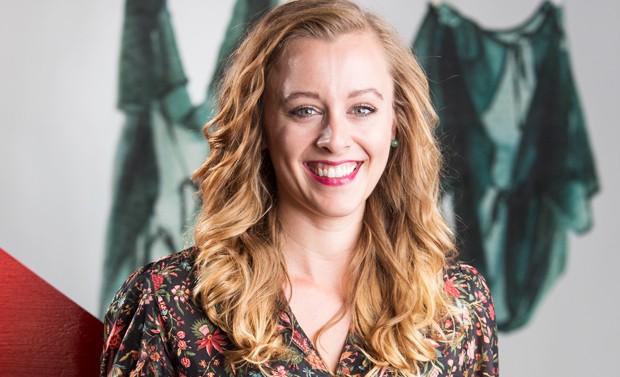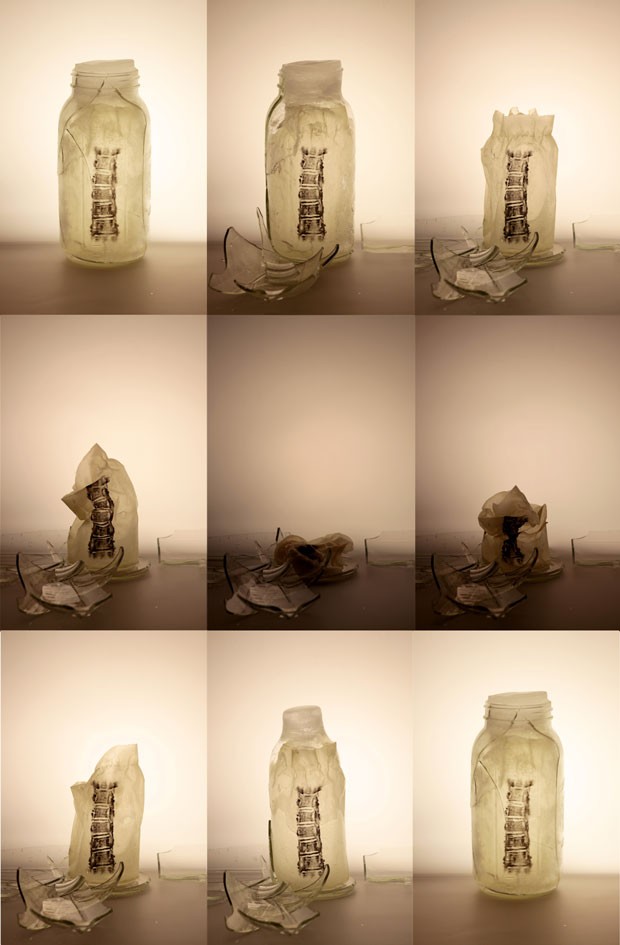‘I hope to prove what the arts can offer medical care’
How does this specific image (above) relate to your research?
DARIAN STAHL: It's a collection of stills from my recent time-lapse video project on the effects of an autoimmune disease. The video depicts an ice sculpture and its subsequent destruction and reformation.
To begin, a spinal MRI scan is impressed into the surface of a skin-like sack. This flesh-coloured sack is then placed into a larger Mason jar, filled with water, and frozen. The expansion of ice cracks the glass jar, an allusion to the neuropathy that plagues the extremities as the body turns against itself.
When the ice melts and the shards of glass fall away, the fleshy MRI is exposed and brought to the surface. The uncovered scan is then crumpled and eradicated — signifying the loss of the image’s power over the psyche.
As a final gesture, the whole process then plays in reverse. The scan, glass shards, and ice are reconstituted to their original for — never wholly unbroken but standing. I see the reversal and continuous loop of melting and freezing as the relapse and remission cycle of multiple sclerosis.
What is the hoped-for result of your project? And what impact could you see it having on people's lives?
DS: My goal is to create opportunities for creative repurposing of medical scanning technologies with physicians and patients. Medical scans can tell physicians all they need to know about a disease, but absolutely nothing about the patient’s daily life living with a diagnosis.
By creating artworks together, we can give space and time for conversations on the impact of illness that could not have occurred in the fast-paced appointment schedule of the doctors’ offices.
My hope is that a fine art engagement with internal medical scans can positively impact patients’ sense of identity and, in turn, change the way a doctor views her patient from a representative object into an irreducible subject.
What are some of the major challenges you face in your research? What are some of the key areas where your work could be applied?
DS: The greatest challenge I face in my research is the acceptance and integration of arts and humanities into medical education. Although the humanities are widely incorporated into medical education in Europe, North America is behind in recognizing their value for the mental health, communication skills, and empathetic capacities for future doctors.
These skills are key for better patient care, especially as we move towards more distanced and technologically advanced medical treatment. In my experience, funding for humanities interventions is only considered when they can be quantifiably proven effective.
This kind of data-driven funding model does not easily fit within qualitative arts pedagogy — the benefits of which might only be felt years afterward or in the privacy of patient-doctor interactions.
Further, I believe medical schools and institutions should employ artists and other creative scholars to teach and implement humanities programs, instead of stretching the capacities of physicians to take on such roles.
I hope to be one of the creative scholars collaborating with medical institutions, not only to see what medical technology can offer for the arts, but also to prove what the arts can offer to medical care.
What person, experience or moment in time first inspired you to study this subject and get involved in the field?
DS: I became interested in this subject when my sister, Devan Stahl, now an assistant professor of Clinical Ethics at Michigan State University, was diagnosed with multiple sclerosis in 2008 at the age of 22. Upon hearing the news of her devastating illness (and later, the callous and aberrant interactions with her neurologist and radiology technicians), I sought to use my fine arts background to help my sister understand and take charge of her new identity as a woman with a disease.
By re-contextualizing her medical scans through printmaking, I aim to humanize her scans’ anonymous and alienating qualities and restore Devan’s sense of agency over her medicalized body.
How can interested STEM students get involved in this line of research? What advice would you give them?
DS: We are privileged at Concordia to have people who are actively investing in interdisciplinary projects between STEM and the fine arts. There is the Convergence Initiative that seeks to build connections between neuroscience and art, FOYER grants, and conferences like the NSERC Science Odyssey. I would recommend any students interested in reaching across disciplines to get involved in these projects.
My advice for working interdisciplinarily is that you do not have to be an expert in all fields. If you are open to sharing specialized knowledge and learning from others who express their knowledge in a very different way, you can create a diverse team that is able to tackle a problem in a new manner.
Interdepartmental collaborations are highly sought after by (those judging applications for) Vanier and FRQNT government graduate scholarships because they produce innovative solutions.
I am always looking for new collaborators in STEM fields. If anyone is working in new advancements in medical scanning technologies, I would like to work with you to see how this tech can be artistically applied to better understand those patients who are most impacted by the results of these medical scans.
By working in interdisciplinary teams, technology and narrative can rise together.
What do you like best about being at Concordia?
DS: I chose to conduct my research at Concordia because of its pioneering research-creation Humanities PhD program — the first of its kind in North America — established in 1973. This program gives me the freedom to work between three disciplines under the supervision of world-class scholars.
Another reason the school was my first and only choice is because of its stellar fine art facilities and inter-university research groups. With the Humanities PhD structure and supervision available, I have been provided the best opportunity to research the medical humanities and reach the goals of my project.
Are there any partners, agencies or other funding/support attached to your research?
DS: I was extremely fortunate to be granted a Vanier Graduate Scholarship. The Vanier funding body seeks interdisciplinary researchers pursuing a PhD in Canada, even if you are an international student like me. This immense support from the Canadian Government gives me the time and space to focus on my research.
Find out more about the Concordia’s Humanities Interdisciplinary PhD program.
To see more of her work, visit Darian Stahl's website.




